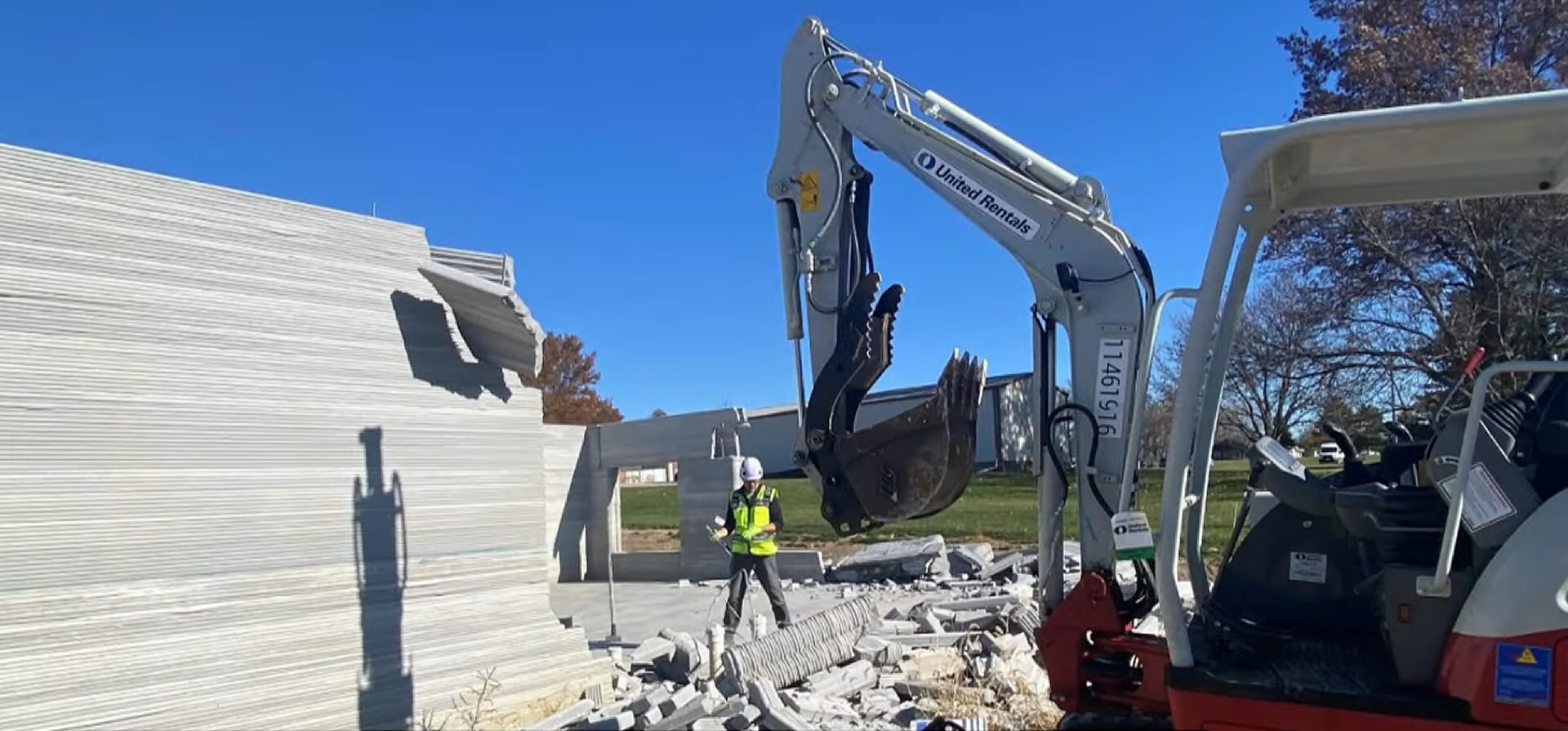For anyone who stopped reading at the headline, it’s because the material they were using didn’t reach the strength requirements of the project (5,000 psi), despite what previous tests had suggested (6,000 to 8,000 psi). With revisions to the material used, they intend to begin working on the second planned house in the spring.
You’re a real one
Is 3D printing houses a gimmick? Why not good old modular houses made in factories and shipped?
Not necessarily, the tech is still new and has its issues that need to be worked out.
Ultimately though, modular houses are nice, but they’re all similar to each other because they’re made in a factory and have a size limit.
3D printed houses have the advantage of being able to be any shape or layout (Within reason) that the builders/homeowners want while still having the potential to be significantly cheaper and faster than standard construction.
Basically, it’s a good middle ground between standard construction and factory modular homes
modular houses are nice, but they’re all similar to each other
I’m not so sure. New American and Canadian houses are famously similar to each other. We build big neighborhood blocks of almost identical looking track houses. If I could, instead, order a house from online catalogs, that might actually increase aesthetic diversity.
We used to have more diversity in housing styles, which is why older neighborhoods have lots of different home styles. But a lot of those 100 year old neighborhoods are actually full of Sears catalog homes. Basically, pre-cut, pre-fabricated modular homes!
*tract, apparently.
having the potential to be significantly cheaper and faster than standard construction
I don’t see how this can ever be true. The only material that can come out of the printer is the concrete for the walls. The walls then have to be reinforced (because concrete is only good under compression), insulated, finished, and then have windows, doors, wiring and plumbing installed… all of which is still just manual labor. The walls aren’t even the expensive part of homebuilding.
It depends on what you’re building. If you want a normal rectangular house, 3D printing will be incredibly inefficient and pointless compared to traditional framing techniques.
On the other hand, if you want curved walls, traditional framing becomes incredibly complex and expensive, whereas 3D printing takes exactly the same materials and labour regardless.
I think 3D printing an entire house is just a gimmick, but it will still be an incredibly useful tool, even if only used for simple things like making rounded foundation pads or retaining walls that follow the landscape or curved hallways connecting modular buildings.
How many people actually want curved walls though?
You need curved couches, shelves, cabinets, windows and picture frames then too.
Geodesic domes housing is even faster to build, but it turns out not very many people like living in circular (or spherical) houses.
How many people actually want curved walls though?
People who hire fancy architects. Not people who have to work for a living.
Maybe not completely a gimmick - you can actually build functional walls with it. But it is nowhere near replacing traditional construction in terms of cost or time.
Personally, I don’t see this process ever getting easier. Concrete pumping is a nasty, complicated and error-prone business. Once you mix concrete it is immediately starting to cure - you have a very limited amount of time before it turns into rock inside the printer. Just think about trying to pump a thick fluid with the density of stone - every part of the system is always on the edge of clogging up. It’s an impressive technical feat that any of these projects actually completed their walls, but none of the advertising videos are showing you how much micromanagement is being done to keep the printers working.
I mean, 3D printing itself was just a gimmick, some niche little curiosity that didn’t have any practical use. Things improve, new use cases emerge, times change.
Sure, but 3D printings greatest advancements have been opening up new engineering possibilities, not replacing old refined and efficient ones.
3D printed complex structures for cooling systems, or molecular structures are things we couldn’t do before. Or printing small batches of rare parts or prototypes that would otherwise require injection mold design and fabrication are great advancements.
We don’t have any problems building houses fast. It’s all financial (capitalistic) and social problems that are making home ownership hard right now.
Here is an alternative Piped link(s):
Piped is a privacy-respecting open-source alternative frontend to YouTube.
I’m open-source; check me out at GitHub.
The real solution would be medium density housing, this is the best in terms of ecology and economy. Buy you know that’s communism or something
Yes, strong agree! Medium density is also the most affordable to build per square footage, compared to low density detached single family homes and high density super tall glass and metal towers.
It might be cynical but 3D printed construction eliminates jobs and thereby increases the share of newly created wealth to the one who owns the means of production, and that seems to be attractive these days, especially if the means or production are priced or regulated out of reach of most everyone.
I’m all for reducing jobs, tax the hell out of the owners of the means of production.
Hell yea, then distribute that money so people aren’t bound to work and can pursue health, hobbies, relationships, self-improvement, take care of their children & parents, or whatever!
Why not wood? I guess progress is funny like that. We reach the end of one era where we’re masters at one technique, only to leap to the next era where we’re completely clueless using a new one. I’m sticking with wood, it’s been good to me lol.
Wood isn’t particularly sustainable the way it is being “farmed.”
We’re annihilating the rainforests and interior forests of north-west North America to build homes, and its not sustainable at all.
The pine beetle epidemic that has ravaged the interior forests of British Columbia is due to two things. One is warmer winters from climate change. The other is that the logging industry replanted the logged forests with the species of pine they could sell the easiest, not what was good for the forests or the land. if they had planted any sort of diversity of trees it would not have been nearly as bad as it turned out.
It definitely sucks. The difference in quality between the pine boards my dad purchased at the hardware store for projects when I was a child, vs the pine boards available now when I get some for a project is NUTS. The number of rings visible on the end has dropped from a dozen or more to a mere handful, they’re way less dense than they used to be.
I fucking HATE buying lumber because it’s an all day ordeal to sort through the stack of boards to find a dozen that aren’t warped, crooked, knotted, rough edged, or missing a corner because it came from the very edge of the log. I almost wish they’d leave an open space next to the stack so I could stick all the trash boards there as I go through them, because only one out of every ten to fifteen is actually usable for anything where precision or appearance matters.
Or you can choose to pay a premium over the already absurd (but appropriate, considering the factors you mentioned) for “Select” grade boards. It’s legitimately difficult to build any kind of furniture type project under what it would cost to buy from a company producing the same thing using an economy-at-scale advantage.
My friend, you need to find yourself a lumberyard. The framing lumber is for framing, and the select boards are not worth it unless you need exactly one board. Not that I haven’t done the same thing with “2-by” material, but it’s hard to complain. Those teenaged twigs in Home Depot are plenty strong enough to hold up a house and are way more sustainable than the beauties our ancestors nailed together and hid behind lath and plaster walls. Not quite THIS bad, but sad in its own way.
Also, the trick is to grab a 2x12 and rip it to width. 😉
Because you can’t as easily slap the word “luxury” in front of “mobile home” and have it be believable.
Pre-fabricated homes are not all mobile homes. I wrote this elsewhere, but a lot of those charming 100 year old homes on the east coast and midwest are pre-fabricated Sears catalog homes.
Still lasted longer than what I 3D-print, so eh.







